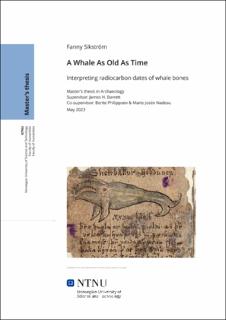| dc.description.abstract | Dette prosjektet har som hensikt å demonstrere relevansen av å datere hvalbein fra arkeologisk kontekst og viktigheten av å benytte en artsspesifikk ∆R. Samt teste teorien at proteinet og fettet fra hvalbein vil gi ulike dateringer. Målet med oppgaven vil derfor være å radiokarbon datere kollagenet og lipidene tatt fra 20 beinprøver hentet fra de tre hvalartene Nordkaper (Eubalaena glacialis), Grønlandshval (Balaena mysticetus), og Gråhval (Eschrichtius robustus).
Når bein fra sjøpattedyr blir datert må det tas hensyn til marin reservoar effekten. Marin reservoareffekten varierer i både tid og rom, og det finnes også variasjon innad ulike arter. Dermed er det nødvendig å benytte lokale kalibreringsverdier kalt ∆R for å få korrekte dateringer. Ved å benytte en Grønlandshval prøve tatt fra kontekst hvor bruksperioden er kjent var det mulig å etablere en arts spesifikk ∆R verdi. Denne verdien er uttrykt som intervallet (-225, -20) eller som (-124 ± 59). Denne gjorde det mulig å korrigere Grønlandshval dateringene.
En annen faktor å vurdere er forfalsshastigheten til materialet som blir datert. Dette er spesielt relevant under datering av langlevende arter, slik som Grønlandshvalen. Proteinet, eller kollagenet, vil ha en betydelig innebygd alder som et resultat av hvalens alder. Mens fettet, eller lipidene, har en hurtigere forfalsshastighet og reflekterer tiden hvalen døde. Å sammenligne dateringen av disse har potensialet til å gi ny innsikt inn i hvordan alderen til arten påvirker dateringen. Lipid ekstraksjonen var vellykket på 7 av prøvene, men dateringene var langt eldre enn hva som skulle vært mulig. FTIR-spektroskopi viste at dette var grunnet finkornet sediment i prøven ble datert i stedet for lipidene. Derfor var det ikke mulig å sammenligne dateringene. Resultatet av dette prosjektet ble 19 daterte kollagenprøver. Seks av disse tilhørte Grønlandshvalen som ble ∆R korrigert og plassert i historisk kontekst. Forskjellen i resultatene før og etter ∆R-korrigering viser viktigheten av å benytte artsspesifikk ∆R. | |
| dc.description.abstract | This thesis aims to demonstrate the relevance of radiocarbon dating whale bones discovered in archaeological contexts and the significance of a species-specific ∆R. It also aims to test the theory that whale bones’ protein and fat content would provide different ages. Its goal is, therefore, to radiocarbon date the collagen and lipid of 20 bone samples collected from the three species North Atlantic Right Whale (Eubalaena glacialis), Bowhead Whale (Balaena mysticetus), and North Atlantic Gray Whale (Eschrichtius robustus).
When radiocarbon dating the bones of marine mammals, you must take into account the marine reservoir effect. The marine reservoir effect varies temporally and spatially, and there is also variation within marine species. So, local corrections expressed as ∆R are necessary in order to get correct calendar dates. By using a Bowhead Whale from a known age context, it was possible to establish a species-specific ∆R value expressed as the interval ( -225, -20) or as (-124 ± 59). With this ∆R correction, it was possible to correct the dates of all the Bowhead samples.
Another thing to consider when radiocarbon dating is the turnover rate of the material that gets dated. This will be especially important to consider when dating long-lived species, such as some species of whale like the Bowhead Whale. The protein, or collagen, will have a significant inherent age due to the old age of the whale, whilst the fat, or lipid, is likely to have a fast turnover rate and reflect the time the whale died. Comparing the date of these two fractions has the possibility to provide insight into how the lifespan of a species affects its dating. While the lipid extraction was successful with 7 samples, they all resulted in significantly older dates than should have been possible. FTIR-spectroscopy showed that this is most likely due to finely-grained sediments being dated and not the actual lipid. Therefore, it was not possible to compare the fractions. The result of this project was 19 successfully dated collagen samples. Six of these were Bowheads and got ∆R corrected and placed in a historical context. The difference in dating results before and after ∆R correcting shows the significance of a species-specific ∆R. | |
